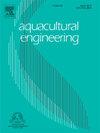利用 SST-IDDES 湍流模型设计近海养鱼场系统的圆筒网状结构中的非稳定流动态响应
IF 4.3
2区 农林科学
Q2 AGRICULTURAL ENGINEERING
引用次数: 0
摘要
圆筒和网箱是近海水产养殖系统的关键要素,更好地理解圆筒和网箱之间相互作用的流动动力学和水动力特征,可以优化环境友好型和可持续的大规模水产养殖围栏的发展。本研究采用高保真计算流体动力学方法,基于大涡模拟区域内经 k-ω 剪切应力传输改进的延迟分离涡模拟湍流模型,研究了圆筒和网箱结构之间相互作用的瞬时流场和水动力响应。采用理查德森外推法评估了不同网格细化程度下数值解的收敛性。研究结果表明,与两个单独的网状物相比,由于网状物与圆柱体、剪切层不稳定性和涡流脱落之间的复杂相互作用,圆柱体的加入导致阻力系数增加了 2.25% 至 36.78%。随着雷诺数和气缸直径的增大,气缸阻力系数降低,导致大规模涡流脱落和不稳定湍流尾流。此外,当固结比和麻绳直径增大时,由于网绳、网孔形状和网绳在流道中的位置造成的干扰,网绳在低流速时的尾流相互作用相对较强。组合圆筒-网状结构的阻力系数和升力系数随着固度比、倾角的增大和流速的减小而增大。傅立叶分析表明,只有圆筒和单一网布的水动力系数主要是低斯特劳哈尔数活动,而圆筒-网布组合结构的水动力主要是与不稳定湍流街道有关的低频活动。了解圆筒和网衣接触尾流附近发生的水动力和流动不稳定性,对于优化近海水产养殖结构的设计,尤其是生物污损情况下的设计,具有极其重要的意义。本文章由计算机程序翻译,如有差异,请以英文原文为准。
Unsteady flow dynamic response in the cylinder-netting structure for the design of offshore fish farm systems using an SST-IDDES turbulence model
An improved comprehension of the flow dynamics and hydrodynamic features of the interaction between the cylinder and nettings, crucial elements of offshore aquaculture systems, can optimize the development of environmentally friendly and sustainable large-scale aquaculture pens. This study investigates the instantaneous flow fields and hydrodynamic response in the interaction between the cylinder and netting structures using a high-fidelity Computational Fluid Dynamics approach based on the k-ω shear stress transport-improved delayed detached eddy simulation turbulence model within the Large Eddy Simulation region. The Richardson Extrapolation method was employed to assess the convergence of the numerical solutions across various levels of mesh refinement. The conducted research revealed that the inclusion of the cylinder resulted in an increase in the drag coefficient ranging from 2.25 % to 36.78 % due to the complex interaction between the combined netting-cylinder, shear layer instabilities, and vortex shedding, when compared to the two individual nettings. As Reynolds number and cylinder diameter increased, cylinder drag coefficients decreased, causing large-scale vortex shedding and unsteady turbulent wake flow. Furthermore, the wake interactions of the netting are relatively strong with low flow velocity when the solidity ratio and twine diameter increased due to the disruption caused by the netting-twine, mesh shape, and netting position in the flow passage. The drag and lift coefficients of the combined cylinder-netting structure increased with increasing solidity ratio, inclination angle, and decreasing flow velocity. The Fourier analysis showed that the hydrodynamic coefficients of only the cylinder and single netting are primarily low-Strouhal numbers activities, while the hydrodynamic forces of the combined cylinder-netting structure are primarily low-frequency activities connected to unsteady turbulent flow streets. The understanding of the hydrodynamic and flow instabilities that occur close to the wake of the contact between the cylinder and the nettings is of utmost significance for the purpose of optimizing the design of offshore aquacultural structures, particularly for situations that are characterized by biofouling.
求助全文
通过发布文献求助,成功后即可免费获取论文全文。
去求助
来源期刊

Aquacultural Engineering
农林科学-农业工程
CiteScore
8.60
自引率
10.00%
发文量
63
审稿时长
>24 weeks
期刊介绍:
Aquacultural Engineering is concerned with the design and development of effective aquacultural systems for marine and freshwater facilities. The journal aims to apply the knowledge gained from basic research which potentially can be translated into commercial operations.
Problems of scale-up and application of research data involve many parameters, both physical and biological, making it difficult to anticipate the interaction between the unit processes and the cultured animals. Aquacultural Engineering aims to develop this bioengineering interface for aquaculture and welcomes contributions in the following areas:
– Engineering and design of aquaculture facilities
– Engineering-based research studies
– Construction experience and techniques
– In-service experience, commissioning, operation
– Materials selection and their uses
– Quantification of biological data and constraints
 求助内容:
求助内容: 应助结果提醒方式:
应助结果提醒方式:


